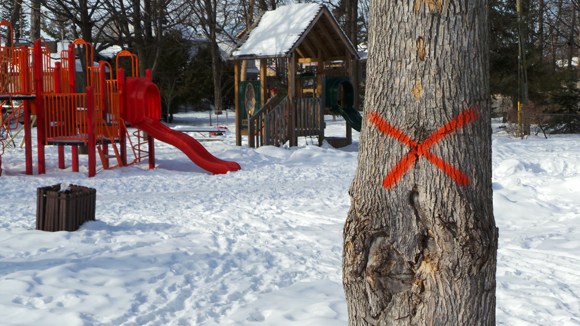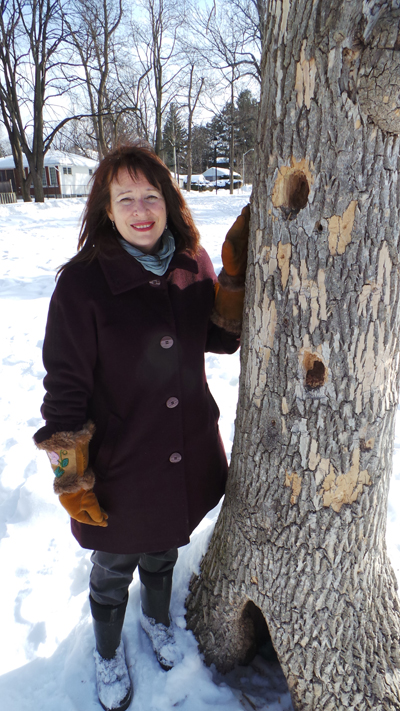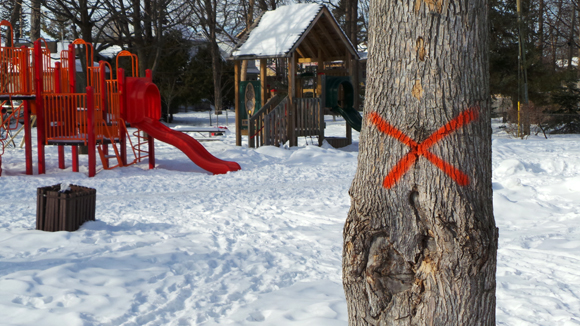Q: Over the past few years I’ve noticed that we’ve lost a LOT of trees in our community. I’m not sure whether disease or insects are to blame (possibly, it’s both), but no where is this loss more apparent than in the little park on Clare Avenue, just east of Churchill. I was driving down the street one day when I suddenly noticed that almost every tree had one of those horrid red X’s spraypainted on them. It was shocking. It’s clear that the majority of the trees will be gone at some point.

We used to visit this park a lot when the kids were small, and part of the reason we did so was because of the wonderful shade. It always seemed a lot cooler at that park than anywhere else. Do you know if there’s a plan in place? What’s going to happen when the trees all come down?
Signed,
A sad neighbourhood tree hugger
–
A: Thank you so much for your question, tree hugger. There are quite a few people who share your concern about the trees in our neighbourhoods. There’s no denying that trees add a lot to our community. Not only do mature trees add much-needed shade, but they provide temperature control, clean our air, provide natural filtration and flood control, and increase our property values. They also support a diverse habitat for local wildlife. There are even studies that suggest neighborhoods with abundant trees have fewer crimes. This may be attributed to the calming effect of green spaces. Time spent outdoors contributes to a feeling of close community, which increases bonds between neighbours. There are plenty of reasons to protect our trees!
Clare Gardens Park received a big overhaul in 2010. Major work was done on the park, including the installation of new play structures. In recent years, the park has become the scene of regular community events. It’s a park that is well used, especially given the shortage of green space available for public use in this part of the neighbourhood.
The gardening side of Clare Gardens has become the domain of The Volunteer Gardeners of Clare Park. Deb Chapman is the co-ordinator.
“People are freaked out about these X’s on the trees,” says Chapman. She estimates that more than 20 trees are slated for removal.

She has been petitioning the City of Ottawa since November in regards to some ideas she’s had that will keep a few of the trees standing and “pay homage to the trees that are going to be taken down.”
She points out specific examples of what other cities have done with their dying trees. The trees can be made into art installations or trimmed back and preserved as a natural habitat for nesting birds. (A Northern Flicker apparently returns to the same nest every year.) The city of Orangeville took trees at the end of their life cycle and turned them into fanciful sculptures. A landscape architect in Quebec turned trees into a modern sculptural garden. Other landscape architects she spoke to told her that the tree trunk could be “lopped off” where the first branches start, the bark removed, and then painted to preserve the wood.
Unfortunately it seems there isn’t much that can be done in the case of Clare Gardens Park. Their days have been numbered for awhile. The trees are dying due to an infestation of the Emerald Ash Borer, a green beetle native to Asia and Eastern Russia. It’s an invasive species that’s highly destructive to ash trees. In order to eradicate the ash borer, the infected trees must be removed entirely.
In a recent email exchange, Andrew Hickey, Manager of Community Relations and Communications for Councillor Hobbs, confirmed that stumps cannot be used for art purposes.
“Once the ash trees are cut then they no have integrity. It is necessary to remove the ash tree stumps so as they do not continue to sprout new trees,” writes Hickey.
“That being said, Forestry is willing to provide other species of wood that could be treated off site and then buried similar to a totem pole. Any art in the park would need the guidance of the Arts Department and Parks as well as a full public consultation.”
This is what Chapman is focusing on now.
She hopes that Ottawa’s population of ash borers will be impacted by the cold winter, but acknowledges that it’s too late for the trees of Clare Gardens Park. She suggests that the park needs more diversity in its trees, so this kind of thing doesn’t happen again.
As it stands now, a landscape artist will re-evaluate how many trees will be planted and the best location to put them. But as we all know, young trees take many years to grow and fill out. It’s going to be a slow process.
Andrea Tomkins,
Editor
Is there an issue in your corner of Kitchissippi that’s been puzzling you? Perhaps there’s something you’ve always wanted to know but didn’t know who to ask. Send your burning questions (Kitchissippi-related of course) to us and we’ll help find the answer.
